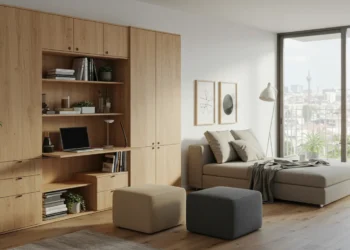Upgrading your home for energy efficiency is more than a trend; it’s a wise investment in the future of our planet and your wallet. As technology progresses and our understanding of sustainable living deepens, the opportunity to make your home more energy-efficient has never been more accessible. This guide will illuminate innovative and practical strategies to enhance your home’s energy efficiency while keeping it cozy and modern.
The Fundamentals of Energy Efficiency
Before diving into specific upgrades, it’s crucial to understand the fundamentals of energy efficiency. At its core, energy efficiency involves reducing the amount of energy required to perform the same job. This can mean anything from installing better insulation to keep your home at a comfortable temperature with less heating and cooling, to using advanced materials and construction methodologies that minimize energy loss.
For those considering more sophisticated energy efficiency upgrades, it’s essential to ensure your home’s electrical system can accommodate new technologies. Consulting a professional electrician can provide you with the necessary guidance and services, whether it’s for retrofitting, installing electrical car charging stations, or integrating smart home automation systems into your current setup.
High-Efficiency Appliances: The Modern Way to Efficiency
When it’s time to replace old appliances, opting for those rated with high energy efficiency can make a substantial difference in your home’s energy consumption. While the upfront cost might be higher, the savings on energy bills over the appliance’s lifespan are usually worth the investment. From refrigerators to washing machines, the market is full of innovative appliances designed to minimize energy use without compromising performance.
Smart Thermostats: A Game-Changer
Smart thermostats have revolutionized how we control the climate in our homes. By learning your schedule and adjusting temperatures accordingly, these devices ensure that you’re not wasting energy heating or cooling an empty house. Moreover, many models provide detailed energy usage reports, helping you understand your consumption patterns and identify areas for improvement.
Energy-Efficient Windows: A Clear View to Savings
Installing energy-efficient windows is another effective way to enhance your home’s thermal performance. These windows are designed to keep the desired indoor temperature in and the external climate out, reducing the energy required for heating and cooling. This upgrade not only contributes to a more sustainable home but also a significant reduction in utility bills.
LED Lighting: Bright Ideas for Saving Energy
Transitioning to LED lighting is among the simplest yet most effective upgrades for energy efficiency. LED bulbs last significantly longer and use a fraction of the energy compared to traditional incandescents. This switch not only saves energy but also reduces the need for frequent bulb replacements, making it both a green and convenient choice for homeowners.
Insulation & Sealing: The Invisible Protectors
Effective insulation and proper sealing are the unsung heroes of energy efficiency. By keeping the outdoor elements at bay and preventing heat or cool air from escaping, these enhancements can drastically reduce the need for artificial heating and cooling. Paying attention to attics, basements, and other areas prone to leaks can lead to significant energy savings and a more comfortable living environment.
Renewable Energy Sources: Harnessing Natural Power
Incorporating renewable energy sources like solar panels can dramatically decrease your reliance on the grid and reduce your carbon footprint. While the initial setup cost can be high, the long-term savings and environmental benefits make this upgrade a compelling option for many homeowners. Additionally, many governments offer incentives and rebates to help offset the installation costs.
Also Read What Are the Best Ways to Save Energy at Home?
Water Conservation: Every Drop Counts
Water efficiency is a crucial part of creating an energy-efficient home. Low-flow toilets, showerheads, and faucets can significantly reduce water usage without sacrificing performance. These simple upgrades can save thousands of gallons of water annually, leading to substantial savings and a lower environmental impact. Combine these with a rainwater harvesting system for even greater efficiency and savings.
Home Energy Audit: The First Step to Efficiency
Before embarking on any energy efficiency upgrades, consider conducting a home energy audit. This assessment can help you understand where your home is losing energy and where your efforts should be focused. Professional auditors can provide you with a detailed report and recommendations, making it easier to prioritize and plan your energy efficiency upgrades effectively.
Final Thoughts
Upgrading your home for energy efficiency is an exciting journey that not only contributes to a healthier planet but also offers significant financial savings over time. By starting with basic changes and gradually incorporating more advanced upgrades, you can transform your living space into a model of sustainability and comfort. Remember, each step you take makes a difference in the larger picture of energy conservation. Let’s embrace these changes together and move towards a more energy-efficient world.









